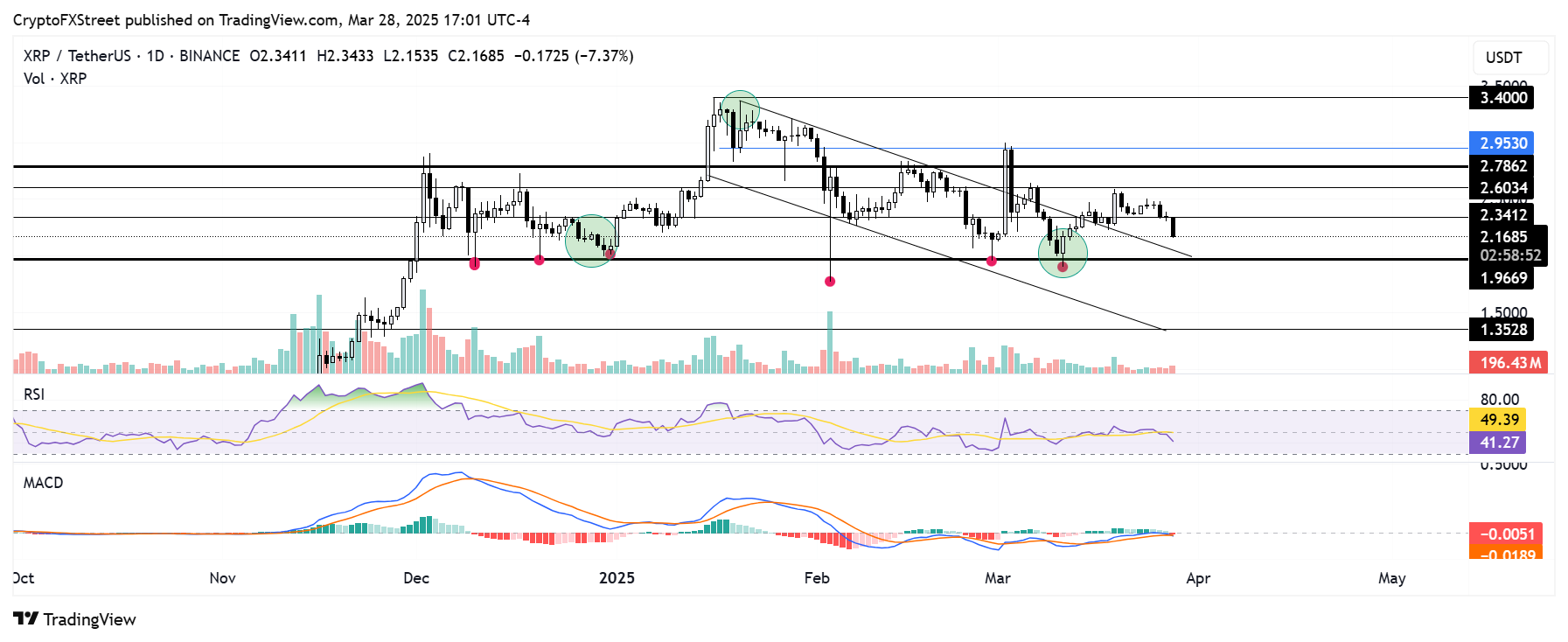XRP Price Forecast: Weak on-chain activity and rising supply sparks downtrend risk
- XRP's price and on-chain activity have been flat despite tailwinds from the SEC dropping its appeal against Ripple.
- XRP's rising supply could cause downward pressure on its price if demand fails to pick up.
- XRP risks a further decline to $1.35 if it validates a Head and Shoulders pattern.
Ripple's XRP is down 7% on Friday following bearish pressure from macroeconomic factors, including United States (US) President Donald Trump's tariff threats and rising US inflation. The downside pressure could accelerate if XRP's on-chain activity fails to pick up amid its rising supply.
XRP on-chain metrics stay mum as supply spikes
XRP — like most cryptocurrencies — has been heavily impacted by Trump’s tariff threats in the past weeks, suffering a 35% drawdown from its peak of $3.40 in January. This largely contrasts with its move in the last quarter of 2024 into early January, where it surged over 500%.
The announcement of the US Securities and Exchange Commission (SEC) dropping its appeal against Ripple also failed to trigger an XRP rally, as prices remained flat. Investors had already largely priced in the outcome, considering the new SEC administration ended several legal cases against crypto companies.
It's unclear whether XRP will see similar moves as it did last quarter again in the current cycle, considering there are no primary tailwinds affecting its price in the coming months and its declining on-chain activity.
Whale investors have scaled down their activity, with their transaction count trending toward pre-US election levels.
 [22.17.56, 28 Mar, 2025]-638787972824872941.png)
XRP whale transaction count. Source: Santiment
Additionally, XRP exchange reserves across Binance and Upbit — which host the largest XRP supply — have been fairly flat since the beginning of March, indicating low accumulation or distribution around the token.
On the derivatives side, XRP's open interest is gradually recovering, rising to 1.75 billion XRP from a monthly low of 1.35 billion XRP, per Coinglass data.
However, XRP risks declining from supply-side pressure if demand fails to pick up in the coming months. Ripple unlocks 1 billion from its escrow monthly, with an average of 33% of the unlocked supply hitting the market gradually. This is visible in its circulating supply growth in the past year, increasing sharply from 54 billion to 58 billion XRP.
 Top 5 Cryptocurrencies-638787974106999959.png)
XRP circulating supply growth
XRP could fall to $1.35 if it validates Head & Shoulders pattern
XRP saw $24.89 million in futures liquidations in the past 24 hours, per Coinglass data. The total amount of long and short liquidations accounted for $23.63 million and $1.26 million, respectively.
The remittance-based token declined below the support near $2.34, recording a 7% loss on the daily timeframe.
XRP could be on the verge of validating a Head-and-Shoulders (H&S) pattern if it breaches the $1.96 support — just below the $2.00 psychological level. Such a move could send XRP toward the $1.35 support level.
On the contrary, XRP could bounce off the $1.96 support as bulls have defended the level on six occasions since its rally above the level last December.

XRP/USDT daily chart
The Relative Strength Index (RSI) and Moving Average Convergence Divergence (MACD) have crossed below their neutral levels and moving averages, indicating rising bearish momentum.
A daily candlestick close above $2.60 will invalidate the thesis and potentially send XRP to test the $2.78 resistance.
Ripple FAQs
Ripple is a payments company that specializes in cross-border remittance. The company does this by leveraging blockchain technology. RippleNet is a network used for payments transfer created by Ripple Labs Inc. and is open to financial institutions worldwide. The company also leverages the XRP token.
XRP is the native token of the decentralized blockchain XRPLedger. The token is used by Ripple Labs to facilitate transactions on the XRPLedger, helping financial institutions transfer value in a borderless manner. XRP therefore facilitates trustless and instant payments on the XRPLedger chain, helping financial firms save on the cost of transacting worldwide.
XRPLedger is based on a distributed ledger technology and the blockchain using XRP to power transactions. The ledger is different from other blockchains as it has a built-in inflammatory protocol that helps fight spam and distributed denial-of-service (DDOS) attacks. The XRPL is maintained by a peer-to-peer network known as the global XRP Ledger community.
XRP uses the interledger standard. This is a blockchain protocol that aids payments across different networks. For instance, XRP’s blockchain can connect the ledgers of two or more banks. This effectively removes intermediaries and the need for centralization in the system. XRP acts as the native token of the XRPLedger blockchain engineered by Jed McCaleb, Arthur Britto and David Schwartz.

